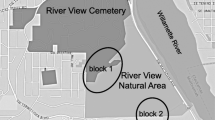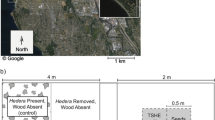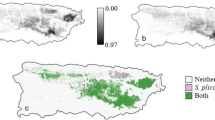Abstract
Floodplain forests in rapidly changing landscapes with increased urbanization may reshape habitat conditions to the detriment of native biota and favor invasive species. We assessed whether introduced Ligustrum sinense distribution and abundance are causally linked to urbanization and whether mechanisms that promote L. sinense cause the demise of native plant species. We surveyed vegetation in 12 independent floodplain forests along an urban to rural gradient in South Carolina, USA. We then used a seedling transplant experiment in nine watersheds to assess how increased urban development affects survival and growth of L. sinense and three native species over two growing seasons. Urban development ranged from 1 to 45% and L. sinense cover was positively associated with development. However, in our transplant experiment, growth and survival of L. sinense did not differ significantly among watersheds. Native species were able to survive at all sites, but performance varied greatly among sites and species but not as a function of urban development. Our results suggest that although L. sinense invasion and urbanization are related (likely due to proximity of propagules from urban sources), the demise of native species cannot be explained by increased urbanization or changes in edaphic conditions and points to L. sinense as an agent of change in our floodplain forests. These results indicate that all floodplain forests are at risk of invasion if propagules arrive and that land managers need to be vigilant against new species introductions regardless of the proximity to urban areas.







Similar content being viewed by others
References
Bartuszevige AM, Gorchov DL, Raab L. 2006. The relative importance of landscape and community features in the invasion of an exotic shrub in a fragmented landscape. Ecography 29:213–22.
Bradley BA, Blumenthal DM, Wilcove DS, Ziska LH. 2010. Predicting plant invasions in an era of global change. Trends Ecol Evol 25:310–18.
Brown D, Johnson K, Loveland T, Theobald D. 2005. Rural land-use trends in the conterminous United States, 1950–2000. Ecol Appl 15:1851–63.
Brown JH, Sax DF. 2004. An essay on some topics concerning invasive species. Austral Ecol 29:530–6.
Burton M, Samuelson L. 2008. Influence of urbanization on riparian forest diversity and structure in the Georgia Piedmont, US. Plant Ecol 195:99–115.
Cadenasso M, Pickett S. 2001. Effect of edge structure on the flux of species into forest interiors. Conserv Biol 15:91–7.
Carpenter D, Cappuccino N. 2005. Herbivory, time since introduction and the invasiveness of exotic plants. J Ecol 93:315–21.
Chytry M, Jarosik V, Pysek P, Hajek O, Knollova I, Tichy L, Danihelka J. 2008. Separating habitat invasibility by alien plants from the actual level of invasion. Ecology 89:1541–53.
Davis M, Chew MK, Hobbs RJ, Lugo AE, Ewel JJ, Vermeij GJ, Brown JH, Rosenzweig ML, Gardener MR, Carroll SP, Thompson K, Pickett STA, Stromberg JC, Del Tredici P, Suding KN, Ehrenfeld JG, Grime JP, Mascaro J, Briggs JC. 2011. Don’t judge species on their origins. Nature 474:153–4.
Dolan R, Moore M, Stephens J. 2011. Documenting effects of urbanization on flora using herbarium records. J Ecol 99:1055–62.
Dukes J. 2001. Biodiversity and invasibility in grassland microcosms. Oecologia 126:563–8.
Eschtruth AK, Battles JJ. 2009. Assessing the relative importance of disturbance, herbivory, diversity, and propagule pressure in exotic plant invasion. Ecol Monogr 79:265–80.
Flory SL, Clay K. 2009. Invasive plant removal method determines native plant community responses. J Appl Ecol 46:434–42.
Gavier-Pizarro G, Radeloff V, Stewart S, Huebner C, Keuler N. 2010. Housing is positively associated with invasive exotic plant species richness in New England, USA. Ecol Appl 20:1913–24.
Greene BT, Blossey B. 2012. Lost in the weeds: Ligustrum sinense reduces native plant growth and survival. Biol Invasions 14:139–50.
Grimm NB, Foster D, Groffman P, Grove JM, Hopkinson CS, Nadelhoffer KJ, Pataki DE, Peters DP. 2008. The changing landscape: ecosystem responses to urbanization and pollution across climatic and societal gradients. Front Ecol Environ 6:264–72.
Groffman PM, Bain DJ, Brand LE, Belt KT, Brush GS, Grove JM, Pouyat RV, Yesilonis IC, Zipperer WC. 2003. Down by the riverside: urban riparian ecology. Front Ecol Environ 1:315–21.
Homer C, Huang C, Yang L, Wylie B, Coan M. 2004. Development of a 2001 National Landcover Database for the United States. Photogram Eng Remote Sens 70:829–40.
Hook DD Jr, McKee WH, Williams TM, Jones S, Blaricom DV, Parsons J. 1994. Hydrologic and wetland characteristics of a Piedmont bottom in SC. Water Air Soil Pollut 77:293–320.
Hutchinson T, Vankat J. 1997. Invasibility and effects of Amur honeysuckle in southwestern Ohio forests. Conserv Biol 11:1117–24.
Keane RM, Crawley MJ. 2002. Exotic plant invasions and the enemy release hypothesis. Trends Ecol Evol 17:164–70.
Kuhman TR, Pearson SM, Turner MG. 2010. Effects of land-use history and the contemporary landscape on non-native plant invasion at local and regional scales in the forest-dominated southern Appalachians. Landsc Ecol 25:1433–45.
Levine JM. 2001. Local interactions, dispersal, and native and exotic plant diversity along a California stream. Oikos 95:397–408.
Lockwood J, Cassey P, Blackburn T. 2005. The role of propagule pressure in explaining species invasions. Trends Ecol Evol 20:223–8.
Loewenstein NJ, Loewenstein EF. 2005. Non-native plants in the understory of riparian forests across a land use gradient in the Southeast. Urban Ecosyst 8:79–91.
MacDougall AS, Turkington R. 2005. Are invasive species the drivers or passengers of change in degraded ecosystems. Ecology 86:42–55.
McDonald R, Urban D. 2006. Edge effects on species composition and exotic species abundance in the North Carolina Piedmont. Biol Invasions 8:1049–60.
McKinney M. 2002. Urbanization, biodiversity, and conservation. BioScience 52:883–90.
Merriam RW. 2003. The abundance, distribution and edge associations of six non-indigenous harmful plants across NC. J Torrey Bot Soc 130:283–91.
Miller JH, Chambliss EB, Oswalt CM. 2008. Maps of occupation and estimates of acres covered by nonnative invasive plants in southern forests using SRS FIA data posted on March 15, 2008. 1–1.
Mitchell CE, Agrawal AA, Bever JD, Gilbert GS, Hufbauer RA, Klironomos JN, Maron JL, Morris WF, Parker IM, Power AG, Seablom EW, Torchin ME, Vázquez DP. 2006. Biotic interactions and plant invasions. Ecol Lett 9:726–40.
Morris L, Walck J, Hidayati S. 2002. Growth and reproduction of the invasive Ligustrum sinense and native Forestiera ligustrina (Oleaceae): implications for the invasion and persistence of a nonnative shrub. Int J Plant Sci 163:1001–10.
National Climatic Data Center (NCDC). 2009. Palmer hydrological drought index for the northwest division of South Carolina. http://www7.ncdc.noaa.gov/CDO/CDODivisionalSelect.jsp. Accessed 15 Dec 2009.
Nuzzo VA, Maerz JC, Blossey B. 2009. Earthworm invasion as the driving force behind plant invasion and community change in northeastern North American forests. Conserv Biol 23:966–74.
Osland MJ, Pahl JW, Richardson CJ. 2009. Native bamboo [Arundinaria gigantea (Walter) Muhl., Poaceae] establishment and growth after the removal of an invasive non-native shrub (Ligustrum sinense Lour., Oleaceae): implications for restoration. Castanea 74:247–58.
Park MG, Blossey B. 2008. Importance of plant traits and herbivory for invasiveness of Phragmites australis (Poaceae). Am J Bot 95:1557–68.
Poff N, Bledsoe B, Cuhaciyan C. 2006. Hydrologic variation with land use across the contiguous United States: geomorphic and ecological consequences for stream ecosystems. Geomorphology 79:264–85.
Poff NL, Allan JD, Bain MB, Karr JR, Prestegaard KL, Richter BD, Sparks RE, Stromberg JC. 1997. The natural flow regime. BioScience 47:769–84.
Predick KI, Turner MG. 2008. Landscape configuration and flood frequency influence invasive shrubs in floodplain forests of the Wisconsin River (USA). J Ecol 96:91–102.
R Development Core Team. 2008. R: A language and environment for statistical computing. R Foundation for Statistical Computing, Vienna, Austria.
Schoonover J, Lockaby B, Helms BS. 2006. Impacts of land cover on stream hydrology in the West Georgia Piedmont, USA. J Environ Qual 35:2123–31.
Sung C, Li M-H, Rogers G, Volder A, Wang Z. 2011. Investigating alien plant invasion in urban riparian forests in a hot and semi-arid region. Landsc Urban Planning 100:278–86.
Thompson K, Davis MA. 2011. Why research on traits of invasive plant species tells us very little. Trends Ecol Evol 26:155–6.
Trimble S, Weirich F, Hoag B. 1987. Reforestation and the reduction of water yield on the southern Piedmont since circa 1940. Water Resour Res 23:425–37.
US Fish and Wildlife Service. 2009. Classification of wetlands and deepwater habitats of the United States. http://www.fws.gov/wetlands/. US Department of the Interior, Fish and Wildlife Service. Washington, DC.
Von Holle B, Simberloff D. 2005. Ecological resistance to biological invasion overwhelmed by propagule pressure. Ecology 86:3212–18.
Walsh C, Roy A, Feminella J, Cottingham P, Groffman P, Morgan R. 2005. The urban stream syndrome: current knowledge and the search for a cure. J North Am Benthol Soc 24:706–23.
Walter RC, Merritts DJ. 2008. Natural streams and the legacy of water powered mills. Science 319:299–304.
Ward R. 2002. Extent and dispersal rates of Chinese Privet (Ligustrum sinense) invasion on the upper Oconee River, north Georgia. Southeast Geogr XXXXII:29–48.
Williams NSG, Schwartz MW, Vesk PA, Mccarthy MA, Hahs AK, Clemants SE, Corlett RT, Duncan RP, Norton BA, Thompson K, McDonnell MJ. 2009. A conceptual framework for predicting the effects of urban environments on floras. J Ecol 97:4–9.
Zhang X, Zwiers FW, Hegerl GC, Lambert FH, Gillett NP, Solomon S, Stott PA, Nozawa T. 2007. Detection of human influence on twentieth-century precipitation trends. Nature 448:461–4.
Acknowledgments
BTG was funded by a NSF Graduate Research Fellowship, Cornell University Graduate School, IGERT Small Grant DGE 0221658, and the South Atlantic Chapter of SWS and a Cornell University Hatch grant (to BB). We thank A. Armstrong, K. Parks, and D. Rayner for help and F. Vermeylen for statistical advice. We benefited from comments of M. Bain, B. Bedford, T. Walters, and two reviewers in addition to contributions from the Blossey lab group.
Author information
Authors and Affiliations
Corresponding author
Additional information
Author Contributions
Brian Greene conceived ideas, conducted field work, and analyzed data. Brian Greene and Bernd Blossey designed the study and co-wrote the manuscript.
Electronic supplementary material
Below is the link to the electronic supplementary material.
Rights and permissions
About this article
Cite this article
Greene, B., Blossey, B. Patterns of Privet: Urbanizing Watersheds, Invasive Ligustrum sinense, and Performance of Native Plant Species in Piedmont Floodplain Forests. Ecosystems 17, 990–1001 (2014). https://doi.org/10.1007/s10021-014-9774-4
Received:
Accepted:
Published:
Issue Date:
DOI: https://doi.org/10.1007/s10021-014-9774-4




